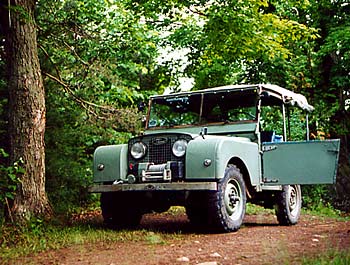|
|
|
Land Rover FAQ Introduction
This section includes general information on what is on these pages. This includes the creators of the site, the history of the FAQ itself, what a Land Rover is, as well as how to join
the land-rover related mailing lists.
Start here for a brief description of the site's
gestalt. We hope you enjoy it. There is a good deal of useful information on the site which we have been compiling since the early 1990s.
|
Land Rover Vehicle Identification
The FAQ also contains information on how to identify specific Land
Rovers (Series I, II, & III), Range Rovers, Discoveries, Lightweights, and Dormobiles). Here we have our Quick Vehicle Identifier. To the uninitiated viewer the difference between the versions of the Series and Defender vehicles is subtle. In these pages we have tried to detail the differences and specifications of each version of the vehicle. Also included is Ident-a-Rover, an interactive program that will help you to identify
what model vehicle you saw.
|
 |
|
Land Rover History, Production, & Sales
Here you will find History, Production, and Sales data on Land Rovers.
There is a timeline of the history of the company, starting with its creation back in 1947, the dark days of Rover under the helm of British Leyland's Solihull stewardship right up until the company's purchase by Ford Motor Co. in May of 2000. You'll also find a history of the vehicles themselves. From Spencer and Maurice Wilks' first prototype Series I on a Jeep chassis way back in '47, all the way to today's highly advanced coil sprung Range Rover, Freelander, Defender, and Discovery models. You will see examples of old advertising,
some quaint and others absolutely hilarious. You'll learn how to decode serial numbers, and also how to get
build sheets on your vehicle as well as production
data and sales data.
|
Land Rover Repair & Maintenance
How to repair and maintain your Land Rovers and an alternate
parts list. There is also a collection of articles & tech tips from the internet
and Ottawa Valley LR Club's newsletters on Series vehicles through Range
Rovers and 101's on various maintenance items. If you need diagnostic fault codes, paint codes, articles on how to do specific repairs right, and how not to do them wrong, adjustment procedures, this is the section you want to explore. Whether you are trying to source a much needed U-joint locally to replacing crumbling window channels in your Series vehicle, this is the place to find it. From the feedback we receive from visitors to the Land Rover FAQ we know that some of these can be really helpful.
|
| |
|
Land Rover Clubs, & Parts Suppliers
Land Rover Parts suppliers, Clubs, Customs Information, Books, and other Publications. There are also URLs for internet resources for your vehicle. These include Web pages, ftp sites and more, both amateur and commercial. If you are looking for a parts supplier or club in your area, this is the place to go. A lot of the clubs have meets or get togethers on some sort of a regular basis. It is a good way to meet other owners of Series and other Land Rovers in your area.
|
Miscellaneous Information Regarding Land Rovers
Here you will find information on the Koenig and Capstan winch. There's
the very popular Anti-FAQ (aka silly answers for silly questions), several pages of Camel Trophy information,
and a listing of Famous Land Rover owners. There are adventure stories, a listing of toys, crossword puzzles, and, if you would rather lick 'em, a philatelic section (that would be stamps for the lay people among us). Lots of fun stuff!
|
| |
|
What's New on these pages!
This is a list of recent changes to the LandRover FAQ, in reverse chronological order. Check
back here to see if any new information has shown up since your last visit.
|
Index
Here is a list of everything on the site. You wil also find a time
index that
is sorted by file modification times.
|
| |
|
The Land Rover Series I
The vehicle that started it all

Land Rover Series I 80 Inch Specifications:
Initial Production Date: 1948
Length: 11 feet
Width: 5 feet 1/2 inch
Height: 6 feet
Wheelbase: 80 inches
Track: 4 feet 2 inches
Top Speed: 57.75 mph
Accelleration 0-60: Ummm.... see above
Fuel Mileage: About 21mpg
Construction: Aluminum body on steel box frame
Engine: 1.6 Liter 4 cylinder petrol, overhead inlet side exhaust valves in a cast iron block, roller tappet camshaft, 55 horsepower
Horsepower: 50hp
Compression Ratio: 6.8 to 1
Fuel System : Single Solex down draft carburetor, electric Lucas diaphragm type fuel pump
Fuel Capacity: 10 gallons
Electrical System: 12 volt positive earth
Oil Capacity: 5 quarts
Transmission: Full time four wheel drive with a freewheeling transfer case. Four speed main gearbox with synchromesh on 3rd and 4th gears
Transfer Case: Two speed Hi/Low range with internal lockable differential. Provision for Power Takeoff units
Power Takeoff: Available at front, center, and rear. PTO options included a capstain winch, circular saw, thresher, brush mower, snow thrower, welder generator, hydraulic pump, belt drive drum, and other various farm impliments
Clutch: Hydraulically actuated dry clutch plate
Braking System: Hydraulically actuated 9 inch drum brakes
Axles: Beam type, open differential with leaf springs
Tires: 6.00 X 16
inches
Price: £450 (In 1947 that was a LOT of money! Even for a LandRover!) |
Copyright Dixon Kenner, 1995-2023.
Last modified September 23, 2023.
Comments? Send mail to Dixon Kenner or
Benjamin Smith
Site Designed and Created by Bill Maloney
|
|



















